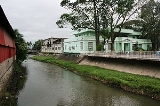
Bay River
Encyclopedia

Bay, Laguna
Bay is a 3rd class also considered as 2nd class municipality in the province of Laguna, Philippines. According to the latest census, it has a population of 60,756 inhabitants in 15,194 households...
. It is one of 21 major tributaries of Laguna de Bay
Laguna de Bay
Laguna de Bay is the largest lake in the Philippines and the third largest freshwater lake in Southeast Asia after Tonle Sap in Cambodia and Lake Toba in Sumatra, Indonesia. It is on the island of Luzon between the provinces of Laguna to the south and Rizal to the north...
and is the more southern of two small rivers that hem the town proper of Bay.
The other is the Calo River (Tagalog: Ilog Calo), another Laguna de Bay tributary, to the north. In geographical terms, these two rivers created the main area of the town of Bay by leaving many centuries' worth of alluvial deposits in the lower section of the plain close to Laguna de Bay.
That plain, in time, was selected by the earliest settlers of Bay as the site of their community, because the access to the lake meant easy transportation and ready access to a source of water.
The downside to this choice of location was regular flooding. Residents still recall that when the two rivers overflowed their banks, the poblacion and six other barangays would be flooded. However, this rarely happens today because an irrigation system consisting of canals and ditches which bring water from these rivers into the ricefields have reduced the force of the waters.
The Bay River forms Bay's boundary with Calauan, Laguna
Calauan, Laguna
Calauan is a 3rd class municipality in the province of Laguna, Philippines. According to the latest census, it has a population of 54,248 people in 8,818 households.The town got its name from the term kalawang, which means rust...
. A third river on the opposite side of the town, the Maitem River (Tagalog: Ilog Maitem), forms Bay's boundary with Los Baños, Laguna
Los Baños, Laguna
The Nature and Science City of Los Baños is a 1st class urban city in the province of Laguna, Philippines. According to the latest census, it has a population of 98,631 inhabitants in 17,030 households...
.
See also
- Laguna de BayLaguna de BayLaguna de Bay is the largest lake in the Philippines and the third largest freshwater lake in Southeast Asia after Tonle Sap in Cambodia and Lake Toba in Sumatra, Indonesia. It is on the island of Luzon between the provinces of Laguna to the south and Rizal to the north...
- Laguna Lake Development AuthorityLaguna Lake Development AuthorityThe Philippines' Laguna Lake Development Authority abbreviated as LLDA is one of the attached agencies of the Philippines' Department of Environment and Natural Resources responsible in the preservation, development and sustainability of the Laguna de Bay and its 21 major tributary rivers.- History...

